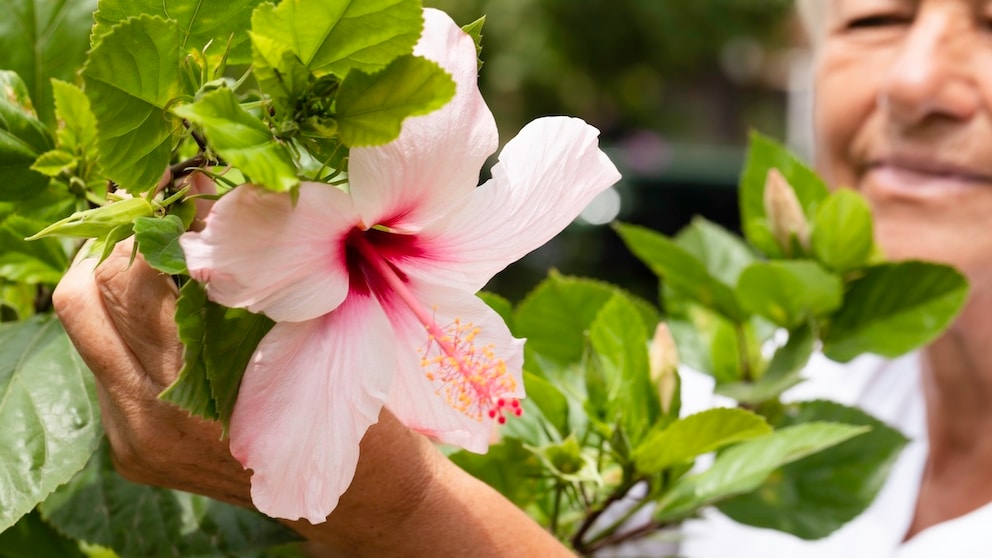March 6, 2025, 2:19 pm | Read time: 4 minutes
The right pruning not only gives the hibiscus a beautiful shape but also promotes its health and flowering power. Whether for young plants, established shrubs, or older specimens — here, you will find practical tips for the right pruning.
With its bright flowers, the hibiscus brings color and tropical flair to the garden. To keep it healthy and allow it to develop its full flowering splendor, the right care is crucial. Find out below which pruning techniques are suitable for which growth phase and the best way to prune hibiscus.
Why Should You Prune Hibiscus?
Regular pruning keeps the hibiscus in shape, promotes flower formation, and strengthens the plant. Although pruning is not absolutely necessary, if you want a lush, vital flowering shrub, you should reach for the shears regularly.
The Right Tools and Hygiene
Sharp secateurs are usually sufficient for pruning. If thicker branches need to be removed, pruning shears or a small hand pruning saw are helpful. It is important that the tool is sharp to avoid bruising the branches and clean to prevent the transmission of diseases. Smooth cuts heal faster and protect the plant.
The Best Time for Pruning
The ideal time for pruning is from late winter to early spring, as soon as the heavy frosts have passed. During this phase, the hibiscus gathers strength for new shoots, and the fresh cuts heal more quickly. In addition, you have a good overview of the buds and shoots before budding when they are bare.
Training Pruning for Young Hibiscus Plants
Damaged and weak branches should already be removed when planting a young hibiscus. The remaining shoots should be shortened by about half to stimulate branching.
In subsequent years, the plant should continue to be pruned back severely by around a third or half of the previous year’s shoots. This creates a strong framework that ideally consists of four to seven ground shoots. Ground shoots that grow beyond this are removed.
To support the desired formation of a shrub shape, the lateral ground shoots are pruned slightly more than the shoots that grow furthest in the middle of the plant. In addition, the lateral ground shoots should be cut so that the uppermost eye points outwards so that the new shoots grow in the right direction. New side shoots of the scaffold shoots are shortened to five to ten centimeters. In addition, diseased, inward-growing shoots that are too close together and competing shoots are regularly cut off. These pruning measures are maintained until the hibiscus has reached its final size.
Maintenance Pruning for Older Hibiscus Plants
Once the hibiscus has developed its desired shape, maintenance pruning is sufficient. Weak or dead shoots are removed, while the previous year’s flowering shoots are shortened down to a few buds. To prevent excessive thickening of the crown, occasional thinning is advisable.
Rejuvenation Pruning for Old or Flower-Deficient Plants
If the hibiscus has not been pruned for years and only bears a few flowers, rejuvenation pruning can help. To do this, the main shoots are cut back at different heights, between 30 and 50 cm above the ground. This causes the plant to sprout vigorously in the following months. In summer, this new growth should be thinned out considerably.
After rejuvenating pruning, the hibiscus often does not flower in the first year as it puts its energy into growing new shoots and leaves. During dry summer months, the plant should be watered regularly to support the regeneration process.

Planting and caring for blackcurrants in the garden

Prune tomato plants correctly for a bountiful harvest

When to prune rhododendrons
Growing a Hibiscus Standard Plant
Hibiscus standard stems are available commercially, but you can also grow them yourself. To do this, a strong shoot is first selected as the future trunk, while all other shoots are removed. In the first year, the main shoot remains uncut. New ground shoots and side shoots forming on the main shoot must be removed regularly.
As soon as the main shoot has slightly exceeded the desired height of the crown base, it is shortened in spring. This encourages it to branch out laterally. Four to five of the new branches that form high up are retained. They are shortened by half so that they can branch out properly and form a compact and healthy crown.

